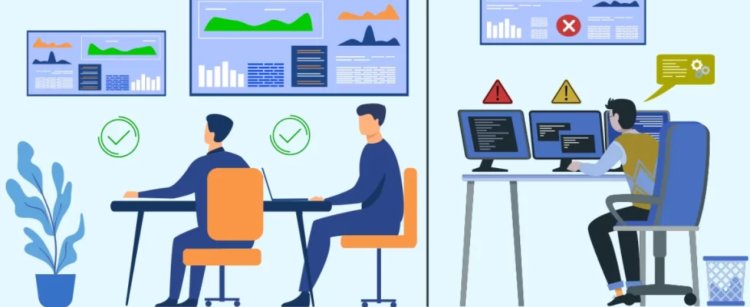Proactive Application Monitoring: Prevent Downtime and Ensure Peak Performance
Learn how proactive application monitoring prevents downtime and ensures peak performance. Discover the role of DevOps services and solutions in optimizing application reliability and user experience.

In a digital-first world, application downtime can lead to lost revenue, reduced customer trust, and reputational damage. Businesses need more than reactive fixes they need proactive application monitoring to identify potential issues before they escalate. By integrating DevOps services and solutions, enterprises can enhance visibility, streamline operations, and ensure their applications run at peak performance.
What is Proactive Application Monitoring?
Proactive application monitoring involves continuously tracking application performance, identifying anomalies, and addressing potential failures before they impact users. Unlike reactive monitoring, which only detects issues after they occur, proactive monitoring ensures uninterrupted service and optimal user experience.
Key aspects include:
- Real-Time Alerts: Instant notifications for unusual activity.
- Performance Analytics: Insights into application speed, uptime, and resource utilization.
- Root Cause Analysis: Identifying and addressing underlying issues swiftly.
Benefits of Proactive Application Monitoring
1. Preventing Downtime
Proactive monitoring minimizes unplanned outages by identifying vulnerabilities early. This approach ensures business continuity and prevents disruptions.
2. Enhanced Application Performance
Monitoring tools like New Relic or AppDynamics provide actionable data to optimize application speed and reliability.
3. Cost Savings
By reducing downtime and addressing issues proactively, businesses save on the high costs of emergency fixes and lost productivity.
4. Improved User Experience
Applications that run smoothly foster trust and enhance customer satisfaction, driving user retention and loyalty.
How DevOps Services and Solutions Support Proactive Monitoring
Integrating DevOps services with application monitoring elevates operational efficiency. Key contributions include:
- Continuous Integration and Delivery (CI/CD): Ensures seamless updates without disrupting application performance.
- Automation: Tools like Jenkins or Azure DevOps automate performance tests, enabling faster issue resolution.
- End-to-End Monitoring: Combining infrastructure and application monitoring for holistic performance insights.
- Collaborative Culture: DevOps promotes teamwork, ensuring monitoring insights translate into actionable improvements.
Essential Tools for Proactive Application Monitoring
1. New Relic
Offers real-time application performance monitoring and deep diagnostics.
2. Datadog
Provides full-stack observability, integrating metrics, traces, and logs in one platform.
3. AppDynamics
Specializes in monitoring complex application environments with AI-driven insights.
4. Prometheus
An open-source tool ideal for collecting and querying metrics from infrastructure and applications.
Best Practices for Effective Application Monitoring
1. Define Clear KPIs
Establish measurable performance indicators like response times, error rates, and uptime percentages.
2. Automate Monitoring Tasks
Automation reduces human error and ensures round-the-clock vigilance. Leverage DevOps services and solutions to implement automation effectively.
3. Use Synthetic Monitoring
Simulate user interactions to identify potential bottlenecks before they impact real users.
4. Conduct Regular Health Checks
Perform routine assessments of application and infrastructure performance to maintain optimal operations.
Real-World Use Case: E-Commerce Platform Optimizes Performance
An e-commerce business struggling with frequent downtime partnered with a DevOps services provider to implement proactive application monitoring. By integrating tools like Datadog and automating alerts, they reduced downtime by 60% and improved page load times by 40%. This resulted in a significant boost in user engagement and sales.
FAQs About Proactive Application Monitoring
1. What is the difference between proactive and reactive monitoring?
Proactive monitoring detects and resolves issues before they occur, while reactive monitoring addresses problems after they arise.
2. How does proactive monitoring work with DevOps services?
DevOps services enable continuous delivery, automated testing, and collaborative workflows, ensuring monitoring insights drive actionable improvements.
3. What industries benefit most from proactive monitoring?
Industries like e-commerce, finance, healthcare, and SaaS benefit significantly due to their reliance on high-performing, always-available applications.
4. What are the costs associated with proactive application monitoring?
Costs vary depending on tools and implementation scale. Investing in proactive monitoring often leads to long-term savings by preventing costly downtime.
5. Can small businesses use proactive monitoring?
Yes, small businesses can leverage affordable tools like Prometheus or open-source alternatives to implement proactive monitoring and maintain application reliability.
What's Your Reaction?














